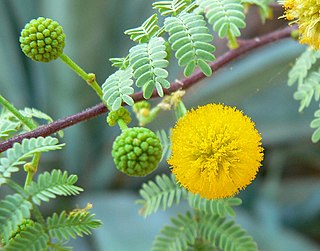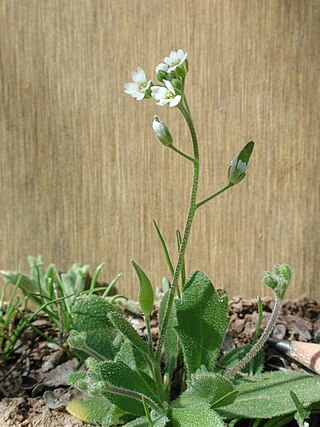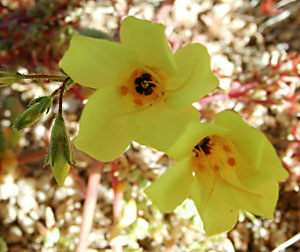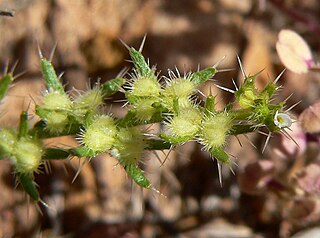
Yucca elata is a perennial plant, with common names that include soaptree, soaptree yucca, soapweed, and palmella. It is native to southwestern North America, in the Sonoran Desert and Chihuahuan Desert in the United States, southern Nevada, southwestern Utah, and northern Mexico. Yucca elata is widely distributed, although its population appears to be decreasing.

Bergerocactus emoryi is a species of cactus, known commonly as the golden-spined cereus, golden snake cactus, velvet cactus or golden club cactus. It is a relatively small cactus, but it can form dense thickets or colonies, with the dense yellow spines giving off a velvety appearance when backlit by the sun. From April to May, yellow, green-tinged flowers emerge, which transform into reddish, globular fruit. This species is native to the California Floristic Province, and is found in northwestern Baja California and a small part of California, in San Diego County and on the southern Channel Islands. Where the Mediterranean climate of the California Floristic Province collides with the subtropical Sonoran Desert near El Rosario, hybrids with two other species of cacti are found. It is the sole member of the monotypic genus Bergerocactus, named after German botanist Alwin Berger.

Stegnosperma is a genus of flowering plants, consisting of three species of woody plants, native to the Caribbean, Central America, and the Sonoran Desert. These are shrubs or lianas, with anomalous secondary thickening in mature stems, by successive cambia.

Stenocereus thurberi, the organ pipe cactus, is a species of cactus native to Mexico and the United States. The species is found in rocky desert. Two subspecies are recognized based on their distribution and height. The Organ Pipe Cactus National Monument is named for the species.

Vachellia constricta, also known commonly as the whitethorn acacia, is a shrub native to Mexico and the Southwestern United States.

Ornithostaphylos is a monotypic plant genus which contains the single species Ornithostaphylos oppositifolia, commonly known as the Baja California birdbush or Baja California manzanita. A large, evergreen shrub in the heather family, this species is near-endemic to northwestern Baja California, with a small population just north of the border in San Ysidro, California. It produces a much-branched inflorescence of white, urn-shaped flowers, and has leathery leaves that appear opposite or in whorls. These characteristics separate it from its close relatives in the region, which include manzanitas (Arctostaphylos), summer holly (Comarostaphylis) and mission manzanita (Xylococcus).

Chaenactis fremontii, with the common names Frémont's pincushion and desert pincushion, is a species of annual wildflower in the daisy family. Both the latter common name, and the specific epithet are chosen in honor of John C. Frémont.

Nolina bigelovii is a flowering plant native to the Southwestern United States, California, and northwest Mexico. It grows in the driest desert areas and at elevations up to 1,500 metres (4,900 ft).

Draba cuneifolia is a species of flowering plant in the family Brassicaceae known as the wedgeleaf draba or wedgeleaf whitlow-grass. This annual plant is native to the southern half of North America where it grows in open, rocky fields and other disturbed areas. The plant forms a basal cluster of leaves, which are thick, widely toothed, and coated in stiff hairs. It bolts one or more erect stems which may approach 40 centimeters in maximum height. Each hairy stem bears an inflorescence of up to 75 small white flowers that continue at intervals down the stem as the stem grows in height. This family and its plants are easy to identify with its 4 petals and 4 sepals arranged like a "cross", either in an "X" or "H" shape, thus the name "Cruciferae". Mustards have 6 stamens usually 4 are taller and 2 are shorter. Fruits are either a long thin silique or short often rounded silicle.

Euphorbia misera is a semi-succulent shrub in the genus Euphorbia commonly known as the cliff spurge or coast spurge. A drought-deciduous shrub, it is typically found as a gnarled, straggly plant occupying seashore bluffs, hills and deserts. Like other members of its genus, it has a milky sap, which can be found exuding out of the light gray bark when damaged. The alternately-arranged leaves are round and folded in the middle, with small hairs on them. The "flowers" can be found blooming year-round, and are colored maroon or yellow in the center with 5 white to light-yellow petal-like appendages attached outside. This species is native to the Baja California peninsula and Sonora in Mexico, and the coast of southern California in the United States, where it is a rare species. It is threatened in some localities by the development of its coastal habitat, which tends to be prime locations for high-end residential and commercial developments.

Leptosiphon aureus is a species of flowering plant in the phlox family known by the common name golden linanthus.
Pectocarya heterocarpa is a species of flowering plant in the borage family known by the common names chuckwalla combseed and mixed-nut pectocarya. It is native to the southwestern United States and northern Mexico, where it grows in desert, mountain and plateau habitat, in scrub, woodland, and open areas. This is an annual herb producing a slender, rough-haired stem prostrate or upright to a maximum length of about 25 centimeters. The small, pointed linear leaves are alternately arranged, widely spaced along the stem. The inflorescence is a series of flowers, each on a curved pedicel. The flower has small green sepals and tiny white petals. The fruit is an array of four nutlets each lined with comblike prickles.

Pectocarya penicillata is a species of flowering plant in the borage family known by the common names sleeping combseed, shortleaf combseed, winged combseed and northern pectocarya. It is native to much of western North America from British Columbia to Wyoming to Baja California, where it grows in many types of habitat, including disturbed areas such as roadsides. This is an annual herb producing a slender, rough-haired stem, mostly decumbent in form, to a maximum length of about 25 centimeters. The small, pointed linear leaves are alternately arranged, widely spaced along the stem. The inflorescence is a series of flowers, each on a curved pedicel. The flower has small green sepals and tiny white petals. The fruit is an array of four nutlets each lined with comblike prickles.

Pectocarya platycarpa is a species of flowering plant in the borage family known by the common names broadfruit combseed and wide-toothed pectocarya. It is native to the southwestern United States and northwestern Mexico, where it grows in many types of coastal and inland habitat, from mountains to desert. This is an annual herb producing a slender, rough-haired stem, generally upright to erect in form to a maximum height of 25 centimeters. The small, pointed linear leaves are alternately arranged, widely spaced along the stem. The inflorescence is a series of flowers, each on a curved pedicel. The flower has small green sepals and a tiny white corolla. The fruit is an array of four flattened, slightly curving nutlets lined with thin teeth.

Pectocarya pusilla is a species of flowering plant in the borage family known by the common names little combseed and little pectocarya. It is native to the west coast of the United States from Washington to central California, where it grows in several habitat types, including disturbed areas such as roadsides. This is an annual herb producing a slender, rough-haired stem, generally upright to erect in form to a maximum height of about 38 centimeters. The small, pointed linear leaves are alternately arranged higher on the stem, and those lower on the stem are oppositely arranged and fused at the bases. The inflorescence is a series of flowers, each on a curved pedicel. The flower has small green sepals with short hooked hairs and a rounded white corolla. The fruit is an array of four flattened nutlets with fringes of comblike hairs.

Pectocarya recurvata is a species of flowering plant in the borage family known by the common names curvenut combseed and arched-nut pectocarya. It is native to the southwestern United States and northwestern Mexico, where it grows in many types of desert habitat. It is an annual herb producing a slender, rough-haired stem, generally upright to erect in form to a maximum height of about 21 centimeters. The small, pointed linear leaves alternately arranged along the stem. The inflorescence is a series of flowers, each on a curved pedicel. The flower has small green sepals and a rounded white corolla. The fruits, borne in groups of four, are curved nutlets fringed with flat teeth, each measuring 2.5 to 4 millimeters long.

Pectocarya setosa, known by the common names moth combseed and round-nut pectocarya, is a species of flowering plant in the borage family.

Phacelia neglecta is a species of flowering plant in the borage family, Boraginaceae. Its common names include alkali phacelia and neglected scorpionweed. It is native to the deserts of the southwestern United States in Nevada, Arizona, and southeastern California, where it grows in varied desert habitat, including areas with alkali soils. It is likely that its distribution extends into Baja California.
Teucrium glandulosum is a species of flowering plant in the mint family known by the common names sticky germander and desert germander. It is native to the Sonoran Desert of Arizona, Baja California, Baja California Sur, and San Bernardino County in California. It grows in rocky desert habitat such as canyons. The plant produces three-lobed leaves on its branching stem. The flowers have purple-streaked white corollas up to 2 centimeters long each with a large lower lobe and smaller lateral lobes. The inside of the flower is very hairy.

Agave gigantensis is a large, flowering agave plant found in Baja California Sur, Mexico. Its name is derived from the area of origin, not its large size. The plant is distinguishable by its red and purple leaves during flowering season. It is able to survive in harsh, rocky conditions and prefers dry and warm environments. The flowers of A. gigantensis are arranged in small clusters which diverge from a main branch. Unlike many other agave plants, A. gigantensis has been traditionally used in food and medicine by communities of western Mexico.

















